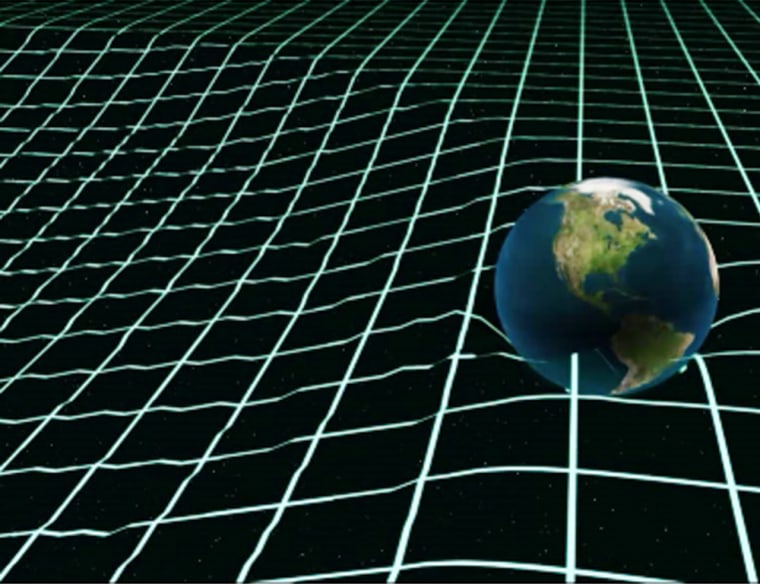After you’ve explained the theory of everything, what do you do for an encore? If you’re Columbia University physicist Brian Greene, author of “The Elegant Universe,” you take on the foundations of the space-time continuum itself.
Greene’s new book, “The Fabric of the Cosmos,” covers some of the same subjects addressed in “The Elegant Universe,” which was published in 1999 and was turned into a public-TV miniseries last fall.
The earlier best-seller focused on relativity and quantum physics, and the effort to reconcile those two incompatible theories by creating an all-encompassing “theory of everything.” For decades, the theory of everything has stood as the Holy Grail of physics — and Greene explained how string theory just might point the way to the grail.
“The Fabric of the Cosmos” updates the quest with developments since “The Elegant Universe” was written, including recent findings on the accelerating universe, the cosmic microwave background and brane theory. But the new book puts the subject in an even broader context, reaching back to the 17th-century puzzles that faced Isaac Newton and looking ahead to the far-future prospects for time machines and wormholes.
Along the way, Greene brings in a fresh crop of pop-culture examples, including so many references to Homer, Bart, Lisa and the neighborhood Kwik-E-Mart that you'd think "The Simpsons" were getting a share of the royalties. Parts of the book still might be tough sledding for nonscientific types, but even in those cases, Greene isn't shy about signaling what you can skip.
On the eve of the book's release, Greene discussed space, time, "The Fabric of the Cosmos" and the current state of the scientific quest:
Q: What makes this book different from “The Elegant Universe, Version 2.0”?
Greene: “The Elegant Universe” was the story of the search for the unified theory, and in writing that book, I tried to stay very close to that goal — to not go down any diversionary paths, no matter how interesting they might be, because I thought that would distract from the main goal of the book.

But while I was writing the book it was as if there were these two other characters, space and time, that kept trying to steal the show. There were so many fantastically interesting things that we’ve learned about space and time in the last 200 years — things that were not quite germane to the story of the search for the unified theory, but are mind-boggling nonetheless.
So this book, “The Fabric of the Cosmos,” is the one in which I’ve allowed space and time to be the true stars, and we really see how our understanding of space and time from Newton until today has gone through remarkable changes, and most importantly, how so many things that we have in our intuition about space and time, their properties and so forth, are just not true to how the world actually works.
Q: A lot of people probably feel as if they already know these characters pretty well. Can you explain what it is that they may not know?
Greene: One thing has to do with so-called quantum entanglement. This is an idea that actually goes back to Einstein, which in its modern description shows that even though two particles may be very far apart in space, they don’t necessarily operate independently, autonomously. Both the theory and experiments have shown that observations done on one particle can be instantaneously correlated with the properties of another particle that may be thousands or millions of miles away — a very strange kind of entanglement through space that arises from quantum effects. In a nutshell, even though two things are separate in space, they’re not necessarily separate.
Q: When you talk about quantum entanglement and teleportation, people might think immediately of the realm of “Star Trek.”
Greene: Sure. The most amazing element of “Star Trek” is the transporter, I think: the ability to “beam” a person or an object from one place to another. Certainly we cannot do that today. But using quantum entanglement, researchers have successfully beamed, if you will, a particle from one place to another. Now, doing that for a particle is a far cry from doing it for a human being. But it is the first baby step in that direction. That is very exciting.
Q: In the book, you touch upon a lot of the science-fiction paradoxes associated with things like time travel. Is it turning out that life getting to be more like science fiction?
Greene: Well, I think that life is getting to be better than science fiction. I think some of the things that have been discovered by physics in the last decade or so are beyond some of the most imaginative science fiction. For instance, in the next generation of atom smashers, if a certain way of thinking about string theory is correct, we may produce microscopic black holes. Through our studies of cosmology, we have learned that galaxies owe their origin to quantum jitters suffusing space. Galaxies are nothing but quantum mechanics, in a sense, written across the sky. These are fantastically interesting ideas.
We've learned in string theory that there may be more than three spatial dimensions. And, if some recent ideas are correct, those dimensions may not be as small as we once thought. For instance, they may not be as small as we thought when I was writing “The Elegant Universe.” And if that's true, we may see evidence of extra dimensions in the next-generation atom smasher, within the decade.
Q: So you think that particle physics is the best avenue for unraveling the cosmic mystery of extradimensional physics?
Greene: I'd say it's one of two. Certainly, atom smashers have proven themselves to be a very powerful tool into the fundamental makeup of the universe. But I personally think that astronomical observations of, say, the microwave background radiation — that's the radiation that we believe is leftover remnants from the Big Bang — precision measurements of that can also give us important clues to the fundamental makeup of the universe, to the idea of whether there are extra dimensions and whether the world is made of strings.
The work I'm doing now is trying to look for signatures of string theory through subtle temperature variations in that radiation that suffuses all of space.
Q: What sorts of missions are coming up that might provide those answers? We've had the WMAP results on the Big Bang's leftovers. Do you think there will be further missions that will provide even more data to resolve those questions?
Greene: I do. There's a mission that's called Planck that will be within the decade, which should better the WMAP observations perhaps by a factor of 10. There's another mission called CMBPol, which is going to be measuring the polarization, a subtle feature of the radiation, that will also give us important clues as to its origin.
It's definitely a long shot. I really mean to stress that — it's a long shot. But there's a chance that these observations of the biggest things in the universe may give us our most precise insight into the nature of the smallest things, the things that ultimately are the source of the radiation and the other structure that we see in the universe.
Q: You probably get this question a lot: What difference does it make for a casual reader what the nature of the cosmic microwave background radiation is? Why should I be interested in that?
Greene: Sure, and more generally, why should you be interested in any of this? I guess my answer is, from the point of view of day-to-day life, I don't think these areas of research are going to result in new gadgets or things that change our day-to-day existence. But I do find, and I know that many people share this perspective, that by understanding the fundamental makeup of the universe — by understanding, for instance, how time is not what we intuitively think it is, and that space differs from our expectations — we begin to see our lives as part of a much richer, a much broader, a much grander framework.
And that, while not resulting in a new gadget, really changes our sense of how we fit into the cosmos. And I think that makes a big difference in how you view your short time here on Earth.
